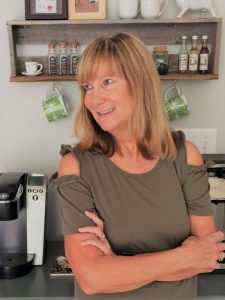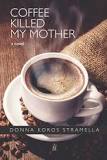Coffee Run Inspiration
Donna Koros Stramella
 Readers often ask me where the inspiration for my novel, Coffee Killed My Mother originated. Curiously, the title came first and was ultimately the inspiration for the book. On one of my frequent coffee runs a number of years ago, I was headed to a drive-thru for a cup and a car nearly hit me on the parking lot. The other driver was likely a fellow coffee lover with a singular mission—get to the coffee as quickly as possible!
Readers often ask me where the inspiration for my novel, Coffee Killed My Mother originated. Curiously, the title came first and was ultimately the inspiration for the book. On one of my frequent coffee runs a number of years ago, I was headed to a drive-thru for a cup and a car nearly hit me on the parking lot. The other driver was likely a fellow coffee lover with a singular mission—get to the coffee as quickly as possible!
From the back seat, one of my daughters said: “Coffee is going to kill you, Mom.” I immediately thought it sounded like a sensational book title. Variations of those words danced around in my head for a long time, and eventually characters and a plot line started to form. I outlined the story, but when I actually started to write, my original concept seemed a bit contrived, so I switched gears to create a strained mother-daughter relationship and the impact of long-held family secrets. At some point, I mostly abandoned my outline. The story had its own flow—all I had to do was capture it as it sped by in my mind.
One friend told me she was reluctant to read my book. Reluctant because she was afraid the novel would unveil something adverse about my childhood. The protagonist, Anna Lee is nothing like me. Neither is the mother, Jacqueline with the exception of her love for coffee.
There are a few tiny snippets in the story that actually happened—to me and to others. As I wrote from Anna Lee’s perspective, I began to see her mother as she saw her—very one-dimensional. I could relate to that from my own childhood.
My mother and father were ideal parents. Although, I can remember a moment in time when I realized they were not perfect. They were flawed like the rest of us. Despite their best efforts, they made some mistakes—like all well-intentioned parents, me included. My most standards, Jacqueline has not been an ideal parent. Yet despite her flaws, she’s made sacrifices for her daughter’s sake. As Anna Lee learns more about her mother, even her mother’s mistakes, she begins to understand both her mother and their relationship more deeply.
Initially, I sketched out both mother and daughter with cursory descriptions. I wanted to give them time to develop. As their personalities and feelings emerged, I started to see them in a more fully human way. That allowed me to consider their choices for themselves—their friends and interests, and even their hair, makeup, and clothing. In my mind, I could envision them, the people around them, their daily lives. I remember author talks over the years, and guidance that insisted, “your characters will take on a life of their own.” Turns out, those authors were right.
In my shorter non-fiction pieces, I’ve written about strong, independent women I’ve known, especially my grandmothers. Their success and struggles propelled me to tell their full stories, to see them as more than the grainy black and white images that show them posing on their wedding days or holding a baby on their hips. They are smiling. It’s easy to remember the laughter. But when I meditate on the pain they faced in their lives, I present them as they really were—not just some virtual home movie reel of the people I want to remember.
In my next novel, Among the Bones, I’m writing about neighbors who are living in a wildly unusual community in the Pacific Northwest. The initial inspiration surfaced in a dream. When I woke up, I immediately recorded the idea so it wouldn’t dissolve into the morning air. With this second book, I have a new female protagonist along with other members of this unique neighborhood. They each have their own story. And collectively, their relationships form sub-stories. Even the setting itself has taken on a life of its own–scents, scenes, sounds.
In recent times, my inspiration is emerging in new ways, allowing me to take the fictional picture in my mind and create a real place on the page. Like many others, I’ve been attending a “writer’s retreat” for the last seven weeks. At least, that’s what I’m calling it. My husband is on a “musician’s retreat” here in the same location. How many times have I dreamt of getting away to a distraction-free place to write? Suddenly, my wish came true. Although certainly not in any way I could ever imagine, especially not with its toll on the world.
Still it’s here, whether I take advantage of this time or not. I’m finding ideas during community walks, as I wave to neighbors from a distance, seeing a reflection of their concern. In the backyard, I watch two squirrels play “king of the jungle,” hoping from branch to branch.
I’m more closely considering budding trees, some already in broad bloom, others appearing dead until I take a closer look. Today’s sky is broadly blue, with paintbrush-like swirls to the north. The joy of life is surrounding me, and I wonder if I allowed myself to full experience it all before. In the morning, I’ll transfer that beauty onto the page. And then I’ll keep looking for more inspiration.
—
COFFEE KILLED MY MOTHER
 Anna Lee is an anxious 17-year-old whose life is stuck, largely because of her strained relationship with her mother Jacqueline, a quirky recovering alcoholic who is now addicted to coffee. The two take off on a trip to explore independent coffee shops along the east coast, but Jacqueline’s real agenda is an opportunity to reveal a series of disturbing family secrets to Anna Lee–a twin that died in utero, a fatal drunk driving accident, an abusive parent, and her mother’s betrayal of a woman Anna Lee holds dear.
Anna Lee is an anxious 17-year-old whose life is stuck, largely because of her strained relationship with her mother Jacqueline, a quirky recovering alcoholic who is now addicted to coffee. The two take off on a trip to explore independent coffee shops along the east coast, but Jacqueline’s real agenda is an opportunity to reveal a series of disturbing family secrets to Anna Lee–a twin that died in utero, a fatal drunk driving accident, an abusive parent, and her mother’s betrayal of a woman Anna Lee holds dear.Category: On Writing






























